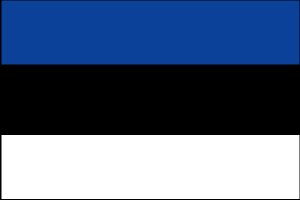
|
Estonia
Background:
After centuries of Danish, Swedish, German, and Russian rule, Estonia attained
independence in 1918. Forcibly incorporated into the USSR in 1940, it regained
its freedom in 1991 with the collapse of the Soviet Union. Since the last
Russian troops left in 1994, Estonia has been free to promote economic and
political ties with Western Europe.
Location:
Eastern Europe, bordering the Baltic Sea and Gulf of Finland, between Latvia
and Russia.
Area: Total: 45,226 sq km, note: includes 1,520 islands in the Baltic Sea,
water: 2,015 sq km, land: 43,211 sq km.
Area - comparative: Slightly smaller than New Hampshire and Vermont combined.
Land boundaries: Total: 633 km, border countries: Latvia 339 km, Russia 294
km.
Coastline: 3,794 km.
Climate and Terrain:
Climate: Maritime, wet, moderate winters, cool summers.
Terrain: Marshy, lowlands; flat in the north, hilly in the south.
Elevation extremes: Lowest point: Baltic Sea 0 m, highest point: Suur Munamagi
318 m.
Natural resources: Oil shale, peat, phosphorite, clay, limestone, sand,
dolomite, arable land, sea mud.
Land use: Arable land: 27%, permanent crops: 0%, other: 73%.
People:
Population: 1,415,681.
Ethnic groups: Estonian 65.3%, Russian 28.1%, Ukrainian 2.5%, Belarusian 1.5%,
Finn 1%, other 1.6%.
Religions: Evangelical Lutheran, Russian Orthodox, Estonian Orthodox, Baptist,
Methodist, Seventh-Day Adventist, Roman Catholic, Pentecostal, Word of Life,
Jewish.
Languages: Estonian (official), Russian, Ukrainian, Finnish, other.
Government:
Government type: Parliamentary republic.
Capital: Tallinn.
Independence: Regained on 20 August 1991 (from Soviet Union.)
Economy overview:
Estonia, as a new member of the World Trade Organization, is steadily moving
toward a modern market economy with increasing ties to the West, including the
pegging of its currency to the euro. A major goal is accession to the EU,
possibly by 2004. The state of the economy is greatly influenced by
developments in Finland and Sweden, two major trading partners.
GDP - composition by sector: Agriculture: 6%, industry: 28%, services: 66%.
Statistics:
Telephones - main lines in use: 501,691.
Telephones - mobile cellular: 711,000.
Radio broadcast stations: AM 0, FM 98.
Radios: 1.01 million.
Television broadcast stations: 3.
Televisions: 605,000.
Internet users: 540,000.
Railways: Total: 968 km.
Highways: Total: 30,300 km, paved: 29,200 km, unpaved: 1,100 km.
Airports: 32,
with paved runways: 8,
with unpaved runways: 24.
Return to Visiting Locations
|

